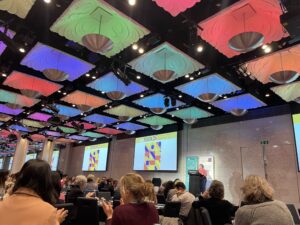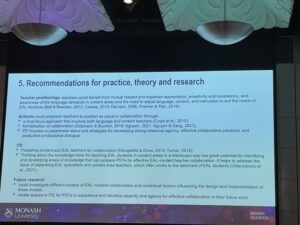On Friday 15 August 2025, the Lexis Education team joined hundreds of educators and researchers at the Pullman Melbourne on the Park for the VicTESOL International Conference. The theme this year was “Transforming Futures: Innovations in TESOL”—and from the buzz in the foyer to the last chat over wine at the reception, the day lived up to that promise.
The event was packed with keynotes, workshops, presentations and flash talks. Here are our highlights from the conference.
Opening Keynote: Transformative L2 Teacher Education Innovations
The day began with Professor Karen E. Johnson (Penn State University), whose keynote drew on Vygotskian sociocultural theory to rethink second-language teacher education. Johnson presented examples such as “tiny talks” that guide novice teachers in developing professional reasoning, and faculty development programs for English-medium instruction in Taiwan. Her message: teacher education must be transformative, not transactional.
Exploring the structure of stories with young learners
Our very own Lynette Lingard delivered a powerful presentation where she outlined how exploring the structure of stories in English is crucial for our young EAL learners. As an EAL specialist teacher in Queensland, she has used various fun and engaging ways of exploring story structures to support her EAL learners to understand, plan and write stories. In her presentation, Lynette explored:
- how understanding story structures supports students to both comprehend and write stories;
- the ways a teacher can engage EAL learners in the process of understanding the structure of stories;
- how to use visuals to make the structure clear to students, along with the use of translanguaging to support EAL learners to gain a greater understanding of the stories they are exposed to;
- the use of purposeful talk, image and text manipulation, and joint construction, as well as the use of repetition and rhyme.
Content language teacher collaboration in multilingual schools: What we learn from theory, research and practice
Dr Minh Hue Nguyen (Monash University) explored how collaboration between EAL and content-area teachers is crucial for supporting multilingual learners as they transition into mainstream classrooms.
The session began with an overview of the Victorian EAL context, before reviewing influential collaboration models from international research. Dr Nguyen highlighted the benefits of collaboration—not only for students, who gain better access to content and language learning, but also for teachers, who develop stronger shared practices.
Drawing on three Victorian case studies (two in secondary schools and one at university level), her presentation showed how both in-service and pre-service teachers can work together effectively. The talk closed with practical recommendations for strengthening collaboration across theory, research and classroom practice, reinforcing its role as a cornerstone of equitable education for EAL students.
Mobilising EAL learners’ cultural and linguistic resources through content and language integrated pedagogy in the Australian EAL classrooms
This presentation, led by Dr Shu Ohki (University of Melbourne), A/Prof Julie Choi (University of Melbourne), Dr Rafaela Cleeve Gerkens (University of Melbourne), Cath Ferla (Western English Language School) and Thea Ho (Western English Language School), examined how Content and Language Integrated Learning (CLIL) pedagogy can help teachers bring EAL learners’ cultural and linguistic strengths into the classroom.
Although CLIL was originally designed for foreign language teaching, the presenters showed how its frameworks—especially the 4Cs Framework and the Language Triptych—offer practical tools for EAL contexts. By using these, teachers can plan lessons that foreground learners’ identities, draw on translanguaging and integrate arts-rich, multimodal approaches that are not yet common in formal EAL classrooms.
The key takeaway: when EAL teachers consistently mobilise students’ cultural and linguistic resources, they don’t just build English proficiency—they also nurture students’ agency, confidence and sense of self, enabling them to bring their “whole selves” into the classroom.
Multilingualism within a Monolingual Habitus: Challenges, Possibilities, and Complexities
The conference closed with Professor Ester de Jong (University of Colorado Denver), who challenged participants to confront the “monolingual habitus” that shapes many educational systems. De Jong highlighted the importance of teacher preparation and school-based practices that move beyond tolerance of linguistic diversity toward genuine multilingual pedagogies. Her talk provided both a critique and a roadmap for embracing linguistic plurality in education.
To sum up
The VicTESOL International Conference 2025 underscored that TESOL is no longer just about English—it is about multilingual futures. It was about a commitment to building classrooms where multilingualism is celebrated, teachers are empowered, and learners thrive.



